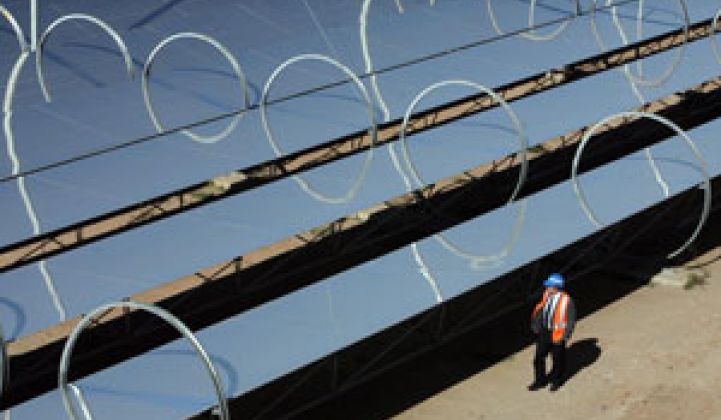More than 12,000 visitors and 210 exhibitors have registered for Intersolar’s inaugural North America show, said Ericka Weber, director of the Fraunhofer Institute for Solar Energy Systems and chairman of the conference, at the opening session Tuesday.
The conference is a sign that Intersolar, which also runs the largest solar conference in Europe, sees the United States as another potentially huge market for the industry.
“At the end of the day [solar] will be the least expensive energy technology of all, including oil, gas, coal and nuclear power,” he said. “So this is the future we have in front of us. We hope to help to ignite this type of solar revolution, which we have experienced in Germany over the last five years. I see no reason [for this not to happen] in the United States too and why not let it happen here in California?”
Intersolar hopes to help California become the first to adopt a strong feed-in-tariff modeled after the German system, he told Greentech Media last week.
After all, Germany’s feed-in tariff, which pays a set price — for solar power, has helped the cloudy, rainy country become the world’s largest solar market. California is even better suited to solar energy, he said.
The same day as the conference officially kicked off, one European company, SolarWorld, announced it is ready to expand in the United States.
SolarWorld, based in Bonn, Germany, said it has completed a new production line in Camarillo, Calif.
The line has the capacity to produce up to 100 megawatts of monocrystalline solar panels, which CEO Frank Asbeck said would help SolarWorld meet “the booming demand” in the U.S. market, according to the announcement.
The company also announced it has entered the North American Solar Challenge, a race of solar-powered cars from Texas to Calgary, Canada, this month.
In other evidence of European-North American crossover, Marlboro, Mass.-based Evergreen Solar (NSDQ: ESLR) inked its largest deal so far, a contract to sell $1.2 billion worth of cells to German-based IBC Solar through 2013.
Meanwhile, solar-energy company Clear Skies Solar, based in Long Island, N.Y., said Tuesday it will open its first office in Europe, in Larissa, Greece. Due to government tax incentives passed in 2006, Greece has become a leading market for solar power, the company said.
Here is some other solar news on Tuesday:
- Sun Well Solar, which installed a 46-megawatt amorphous-silicon line from Oerlikon this year, said it plans to install another 60-megawatt line by the end of this year and an additional 120 megawatts of capacity next year (see Sun Well Rolls Out Thin-Film Panels).
- Sopogy, a company developing solar-thermal power systems for commercial rooftops and ground installations, unveiled a new parabolic trough technology that the company said is more efficient than its previous product and costs less. The cost savings come partly from the use of off-the-shelf rails and prefabricated arms. Customers can save transportation costs because Sopogy ships its systems flat when unassembled, according to the company. Sopogy said the system also includes the world’s first 270-degree tracker for a small concentrating-solar system, as well as features such as storm protection and automatic operation.
- Day4Energy, a solar-panel company that trades on the Toronto Stock Exchange under the ticker “DFE,” said it has completed the first phase of its manufacturing expansion, adding 35 megawatts of production capacity to its previous capacity of 12 megawatts. The expansion is 25 percent larger than originally expected, Day4 said, and the company is now working to add an additional 50 megawatts of capacity for the end of this year.
- The Florida Public Service Commission approved three solar projects for Florida Power & Light Co. that will have the capacity to produce 110 megawatts of solar power, all together, when they are completed in 2010. The first project, announced earlier this month, will have a capacity of 25 megawatts by December 2009 (see SunPower to Build 35MW Plants in Florida). Another photovoltaic project, the Space Coast Next Generation Solar Energy Center, is expected to have a 10-megawatt capacity and to open in the first quarter of 2010. The third project, a solar-thermal project called the Martin Next Generation Solar Energy Center, is expected to have a 75-megawatt capacity and to be completed by 2010.
- Ausra, a solar-thermal company, has opened a subsidiary in New South Wales, Australia to serve the Australian market. The company was originally founded in Australia as Solar Heat and Power before it moved to Palo Alto, Calif., in 2006 (see Ausra Raises $40M for Concentrating Solar-Thermal).
-- Reporter Rachel Barron contributed to this story.



